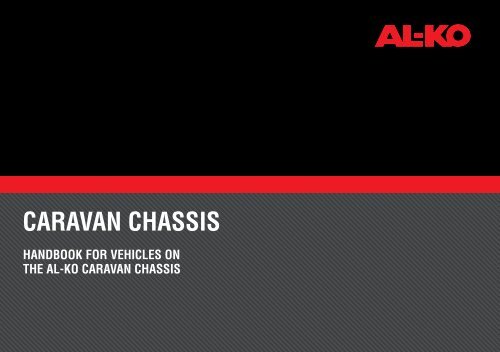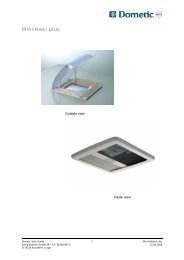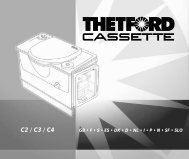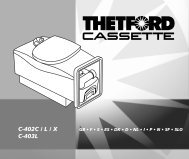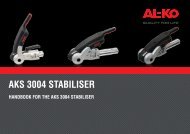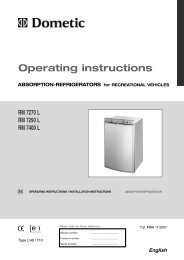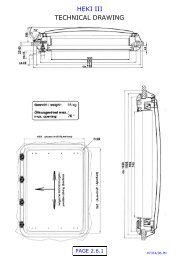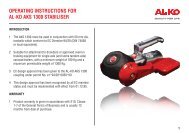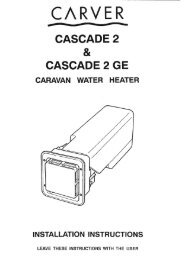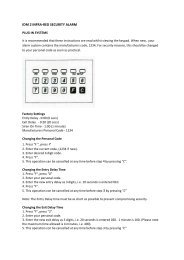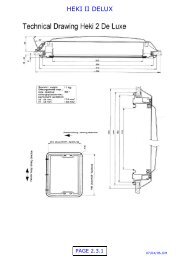Caravan Chassis Handbook - Swift Owners Club
Caravan Chassis Handbook - Swift Owners Club
Caravan Chassis Handbook - Swift Owners Club
- No tags were found...
Create successful ePaper yourself
Turn your PDF publications into a flip-book with our unique Google optimized e-Paper software.
CARAVAN CHASSISHANDBOOK FOR VEHICLES ONTHE AL-KO CARAVAN CHASSIS
AL-KO CARAVAN CHASSISGENERAL INFORMATIONThe AL-KO lightweight chassis has been perfected bymany years of research and development, supported by anexhaustive test programme.Manufactured from high quality steel, the chassis has extradeep sections to provide strength at points of maximumstress. Large elongated holes are punched in the longitudinalchassis members, to reduce weight to a minimum. Each holeincorporates a return flange to maintain the required strengthand provide rigidity in the extra deep sections.AL-KO does not recommend the removal of standard fit accessoryproducts to allow fitment of third party products and cannot beheld responsible should the removal and subsequent fitment ofthird party products causes damage to the chassis components.The process of fitting third party products to the AL-KO <strong>Chassis</strong>therefore may invalidate the chassis warranty.The chassis frame is of a bolted construction which allowsreplacement of individual parts should the need arise.AL-KO <strong>Chassis</strong> and axles are manufactured with the fixingpositions for a range of chassis accessories already included.Some of these accessories are included as standard from thevehicle manufacturer and are positioned for correct and safeusage of these products.For further details on the range of accessory products thatcan be fitted and used with the AL-KO <strong>Chassis</strong>, please referto the Accessories section at the rear of this document,pages 37 - 43.2
AL-KO CARAVAN CHASSISHOT DIP GALVANISATIONThe chassis is Hot Dipped Galvanised. This is regarded as oneof the best forms of corrosion protection. It does howeverrequire minimal maintenance in certain circumstances.When new, the chassis is of a bright and shiny appearance.As the galvanising cures during the initial 2/ 3 monthperiod, this will gradually change to a medium/dark greycolour. This grey finish is the ideal, giving the correctprotective coating. During this curing period the surfaceshould be protected to avoid possible wet storage stain,in the form of a soft, light coloured, porous, oxidationlayer. If the chassis members are in contact with any saltdeposits from roads this should immediately be washed offwith a high pressure washer. Salt attracts moisture allowingthe surfaces to remain wet, this prevents curing and alsoallows formation of wet storage stain.The galvanised chassis should not be painted or subjected to anyother protective treatment.Should the galvanising become superficially damaged exposingthe steel core, this should be cleaned and treated with a ColdGalvanising Spray obtainable from vehicle accessory outlets.Damage to chassis members through impact etc, MUST NOTbe straightened or welded. Damaged chassis members MUSTbe replaced.It is recommended that the chassis/ components are washedoff, using a pressure washer on an annual basis (especiallyafter winter usage), to avoid undesirable build up of salt anddirt deposits.3
AL-KO CARAVAN CHASSISDRILLING OR WELDING OFPARTS OR ACCESSORIESThe chassis is designed and built to precise tolerances andmust not be drilled or welded (except in accordance withcertain AL-KO Accessory Operating Instructions). Failure tocomply will invalidate all warranties.INDEPENDENT SUSPENSIONThe AL-KO rubber suspension is designed and developedto suit all types of road conditions and is maintenance free.Three rubber elements are contained within a hexagonal axletube. These provide suspension and have inherent dampingcharacteristics. (Only the hubs and wheel brakes requireattention - see axle section).LOADINGS ON COUPLING HEADS, OVERRUNASSEMBLIES AND AXLESThe permitted ‘nose’ weights of the coupling head/stabiliser,overrun assembly and drawbars, must never exceed the lowestvalue stamped on the assemblies.The maximum axle loading is that stamped on the plate locatedin the centre of the axle, facing rearwards. The plate will beone of the three shown below - Figs 1, 1a and 2, depending ondate and location of manufacture. The line marked ‘Capacity’(on German plates ‘Achlast’) is the maximum permitted axleloading and must not be exceeded.Where the <strong>Caravan</strong> Manufacturer states a maximum loadingweight, then this is the maximum permitted load. This figuremust not exceed the maximum axle load.AL-KOTYPELECAPACITYkg25km/hTYPAACHLAST EATAMOD.AL-KOkgkgFig 1 Axle Identification Plate Fig 1a New Axle Identification Plate Fig 2 Axle Identification Plate (German)4
AL-KO CARAVAN CHASSISLOADINGLoads to be carried in the caravan should be placed directlyover, or as close as possible to the axles, otherwise thehandling will be impaired.Maximum gross weight, as advised by the caravanmanufacturer, must not be exceeded without approvalfrom AL-KO.Maximum loading is defined as the difference betweenex-works weight and the permitted total weight.Attention should be paid to the legal regulationsregarding the permitted pressure exerted by the towbaron the towed unit.Fig 3 Load Too Far ForwardSteering and braking ability reduced. Increased loading on the rearaxle and chassis of the tow vehicle.Fig 4 Load Too Far BackHigh skid risk together with poor braking effect.Fig 5 Load Over AxleOptimum road holding together with maximum braking effect.Exceptionally heavy loads should be packed directly over the axle.5
AXLE TYPESSAFETY PRECAUTIONSNo welding is permitted on AL-KO Axles.It is important that the wheel and hub/brake drum arecompatible. This means that the PCD, wheelbolts and insetmust all be compatible with both the hub/brake drum andthe wheel rim. Particular attention must be paid to therecommended torque figures for the wheelbolts (page 16).The axle type details shown on axle type plates must not beobscured or made illegible by application of any additionalsurface finish.OPERATING INSTRUCTIONSService BrakeWhen the towing vehicle is braking or travelling down hill,the overrun device shaft is pushed in (dependent on themagnitude of the thrust on the shaft) and presses on theoverrun lever. This acts on the Bowden cables and expandermechanism, which in turn expands the brake shoes applyingthe wheel brakes.ReversingWhen the towing vehicle is reversing, the overrun device shaftis pushing in, applying the brakes via the overrun lever, brakerod system, Bowden cables and the expander mechanism. Thebackwards rotation of the brake drum causes the secondary brakeshoe to collapse cancelling out the braking effect, allowing thetrailer to move backwards. At the same time the transmission leverswings back and compensates for the entire travel.Hand BrakeWith the Euro Hand Brake, pull the lever until upright. The caravanis then braked.IMPORTANT NOTEPlease note that with the handbrake fully applied, the caravan/trailer is able to move backwards by 25 cm until the springcylinder/gas spring takes effect.6
AXLE TYPESMAINTENANCE AND CLEANINGMaintenance of Euro-Plus/Euro- Compact and Euro-Delta.The above semi-trailing axles come fitted with maintenancefree wheel bearings (greased and sealed for life) and noadjustment is necessary.NOTEThe hub bearing is not protected against water ingress.Check wheel brake linings for wear every 10,000 kilometresor every 12 months via the inspection hole (Fig 6/Item 1).Adjust if necessary. Where continuous travel in hilly regionsor high mileage is experienced, earlier inspection andadjustment may be necessary.1NOTEThe flanged hub-nut, located under the dust cap, used to keepthe brake drum in situ, is a ONE-SHOT NUT (ie. must only beused once). If removed it must be replaced with a NEW flangednut - torqued to 290 ± 10 Nm (214 ± 7.5 lbs/ft). A small amountof special mineral grease, available from AL-KO must be appliedto stub axle thread prior to fitting the new flanged nut. After fittingexcess grease must be removed with white spirit.The rear hexagon cap head bolt MUST NOT BE DISTURBEDunder any circumstances. Interference with this nut will result inimmediate tyre wear and damage to the braking system and WILLINVALIDATE ALL WARRANTIES. Should the rear nut accidentallybe disturbed then the complete axle must be returned to AL-KO forresetting of the toe-in and camber.No attempt should be made to remove the bearing. In the eventof damage to the bearing or drum, only the drum complete withbearing and circlip will be available as a spare. No grease is usedin the hub other than the mineral grease on the stub axle. Nogrease should be placed in the DUST cap. This is not a grease capas used in all previous hubsFig 6 Checking wheel brake linings for wear via inspection holes7
AXLE TYPES‘STANDARD AXLE’ MAINTENANCE(TAPER ROLLER BEARINGS)After 1500 km or 6 monthsHave the axial play of the hub bearing checked and adjustedif necessary.After 10,000 km or 12 monthsCheck quantity and quality of grease, renew if necessary.With boat trailers which are driven into fresh/salt water, thehub bearing should be regreased shortly after contact withthe water (with the exception of waterproof hubs). Check thewear of the wheel brake linings every 10,000 km or every12 months through inspection hole (Fig 6) and adjust ifnecessary. Where continuous travel in hilly regions or highmileage is experienced, earlier inspection and adjustmentmay be necessary.SPARE PARTSSpare parts are safety critical parts! For this reason when fittingspare parts in our products we recommend the use of originalAL-KO parts or those parts that we have explicitly approved. Thereliability, safety and suitability of parts designed especially for ourproducts, has been determined using a special test procedure. Inspite of constantly monitoring the market we are unable to assessor vouch for other products.If repair work or servicing is required, AL-KO have a large networkof AL-KO service stations throughout Europe.To establish the correct spare parts required for your axle youshould always quote the axle type (axle identification plate Figs 1/2)and Spare Part Identification no. (ETI No.), which will be stampedonto the wheel brake or identification plate (Fig 7). Please establishthese numbers before contacting AL-KO or a Service Agent.STANDARD AXLE MAINTENANCE(SEALED FOR LIFE BEARINGS)AL-KO Wheel Hubs are fitted as standard with Sealed ForLife bearings which are maintenance free.8
AXLE TYPESETI No.811...Fig 8 Rebound or Free PositionFig 7 Spare Part Identification NumberThe AL-KO rubber suspension axle has been designed& developed to suit all types of road conditions and ismaintenance free.Three rubber elements are contained within an hexagonalaxle tube. These provide suspension and have inherentdamping characteristics.Fig 9 Normal Laden PositionFigs 8, 9 & 10 show the deformation of the rubber elementsat the extremes of suspension movement.The axle is designed to ride with the suspension drop arm at,or slightly below, the horizontal position.For Trouble Shooting & Fault Finding see Table 1 on page 44.Fig 10 Maximum Bump9
AL-KO BRAKING SYSTEM ADJUSTMENT101. Ensure the towing shaft with coupling head is pulledFULLY FORWARD. (Fig 11).2. Release the handbrake to the FULLY OFF position. If thehandbrake will not go down the whole way because ofthe fairing or any other obstruction; then the fairing mustbe cut away and/or the obstruction removed to achievethis desired position. It will not be possible to set up thebraking system properly when the handbrake is not in theFULLY OFF position. (Fig 11).3. Jack up one side of the caravan, using the AL-KO SideLift Jack System. (See Jack Operating Instructions).4. Remove the inner plastic bung from the backplate toexpose the ‘starwheel’ adjuster access. (Figs 11 & 12).5. ALWAYS rotating the road wheel in the forward direction- NEVER backwards; adjust the starwheel with a suitablescrewdriver, in the direction of the arrow embossedon the backplate until there is resistance in the wheelrotation. (Fig 12).6. Slacken off the starwheel adjuster until the road wheelturns freely in the FORWARD direction. (Fig 12).7. Check the adjustment at the end of the brake cable where itis secured to the abutment (bracket), welded to the centre ofthe axle. When the inner cable is pulled out it should extendbetween 5 and 8 mm. (Fig 13a\b). (On tandem axles a doubleabutment (bracket) is fitted to the front axle ONLY).8. Repeat for other wheel or wheels.9. On tandem axles the brake cables from the rear axle shouldpass over this axle and cross over each other before beingconnected to the abutment (bracket) on the front axle. WhereATC is fitted to a tandem axle caravan, the brake cablesSHOULD NOT be crossed over.10. Ensure the balance bar (compensator) is being pulled evenly(Figs 11 & 13a\b). Excessive movement to this bar (double ontandem axles) would indicate possible incorrect adjustment(if appropriate, repeat step No. 7 - Fig 13a\b).11. Check the brake rod support bracket, (fixed to the floor) ISsupporting the brake rod evenly. The brake rod MUST ALWAYSrun straight, NEVER bent or curved under any fittings. Ontandem axles, using the double balance bar, a brake rodsupport tube (Part No. 228827) MUST ALWAYS be fitted on theend of the brake rod, passing through the centre aperture onthe abutment.
AL-KO BRAKING SYSTEM ADJUSTMENTStabiliserFig 11 Brake LinkageHandbrake leverOverrun leverBreakaway cableAxle sideplateBrake rodRotation direction forwardsRubber sprung axleBrake shoeinspection bung‘Starwheel’adjustment accessBalancebar Abutment Bowden cable1Fig 12 Adjusting the Starwheel11
AL-KO BRAKING SYSTEM ADJUSTMENT12. Remove the slack in the brake rod by adjusting the longball nut, rear of the balance bar, ensuring the overrunlever makes contact with the end of the towing shaft.Note! Over adjustment to the long ball nut (Fig 13/Item2) could induce movement of the inner brake cable,reducing the effective clearance of the brake shoes. If theoverrun lever will not make contact, it is possible the twolock nuts, forward of the spring cylinder, are incorrectlyadjusted. Loosen the nuts and adjust brake rod as above(Figs 11, 13a\b).13. OVER ADJUSTMENT of either the wheel brakes orlinkages, will result in difficult reversing causing thewheels to ‘lock-up’.15. Finally, if the road wheels have been removed, re-tighten allM12 wheel bolts using a calibrated Torque Wrench to 110Nmfor Alloy Wheels and 88Nm for steel wheels. The wheel boltsshould be tightened in sequence, ie. North, South, East, WestNOT clock or anti-clockwise (refers to steel wheels only).Remember to over-tighten is just as dangerous as to undertighten,as this can distort the wheel rims. Avoid the use ofpower wrenches.IMPORTANTThe torque settings should be rechecked after 50 km.Wheel bolts should NEVER be lubricated.14. When parking, the handbrake lever MUST ALWAYS beengaged into the fully upright position (90°). If difficultyis experienced in this operation, try easing the caravanbackwards with one hand while engaging the handbrakefully with the other. This manoeuvre should not beattempted on a rearwards facing slope. In this case wheelchocks should be used combined with the handbrake.12
AL-KO BRAKING SYSTEM ADJUSTMENTBalance bar238576002123 4AxleBowden Cable Abutment(welded to axle tube)1- Brake rod2- M10 Ball nut 20888900063- M10 Locknut 7001094- Bowden CablesFig 13a Standard Brake LinkageBalance bar2385760021234AxleBowden Cable Abutment(welded to axle tube)ATCGuide TubeATC Mounting Bracket1- Brake rod2- M10 Ball nut 20888900063- ATC Push Rod4- Bowden CablesFig 13b Brake Linkage with ATC Fitted13
STABILISER AND COUPLING DEVICESYour caravan will be fitted with either an AKS 3004 stabiliseror an AK160/300 coupling head.25°25°SAFETY PRECAUTIONSAlways ensure that the coupling head is properly connectedto the tow vehicle’s towball every time you couple up. If thisprocedure is not carried out correctly, the caravan/ trailermay become detached from the towing vehicle! Maximumpossible articulation of the coupling head must not exceed±25° vertically and ±20° horizontally - see Fig 14.If exceeded, components will be overloaded and theoperation of the assembly adversely affected!25°25°Fig 14 Maximum Articulation Of Coupling Head14
OPERATING INSTRUCTIONSFOR AKS 3004 STABILISERREGULATIONS1. The AKS 3004 must be used in conjunction with 50 mmdia. towballs which conform to EC Directive 94/20 (DIN74058 or local equivalent).2. Suitable for attachment to drawbars or approvedoverrun braking equipment for single (and tandem axle)caravan/trailers, with a minimum weight of 200 Kg and amaximum permissible weight of 3000 Kg.3. EC design approval has been given to the AL-KO AKS3004 coupling under permit No. e1*94/20*0930*00.15
OPERATING INSTRUCTIONSFOR AKS 3004 STABILISERRESTRICTIONS OF USE1. The trailer coupling may only be connected to towingvehicles where the clearances for the stabiliser can beobserved, in accordance with EC Directive 94/20 (DIN74058). If these clearances are infringed by specialattachments, then the use must be checked separately.The area above the towball of the vehicle must be freefrom vehicle components or attachments (A) (eg sparewheels, platforms etc.)MIN. 60mmA B DCThe clearance for the stabiliser handle must be atleast 330 mm (B) + the stroke movement (D) (85mm-100mm), which equates to 440 mm when used inconjunction with an AL-KO overrun.Max. 50 mm (C) clearance between the centre of thetowball and top of the overrun assembly or fairing, toensure both coupling handle and stabiliser handle do notfoul on operation.Maintain the same clearances for othermanufacturers’ overrun assemblies.Fig 20 Clearances for Stabiliser HandleFig 15 Necessary ClearancesMIN. 67mm2. Not suitable for use with overrun devices which can revolveabove 25 (Fig 16) or BPW overruns fitted with gas struthandbrakes from 2001 model year onwards. (If in any doubtabout usage consult your manufacturer).3. Swan Neck towbars (fixed or detachable) are suitable for use withthe AKS 3004 providing they comply to EC Directive 94/20 andhave the required minimum 60 mm clearance, measured from thecentre of the towball (Fig 16).16
OPERATING INSTRUCTIONSFOR AKS 3004 STABILISERSAFETY WARNINGS1. In accordance with EC Directive 94/20, couplings of typeA 50-1 cannot be used (see Fig 17), your warranty will beinvalid if this type of towball is used.25°2. For UK use, use the extended neck towball (type A50-X).3. A bolted-in type ball coupling (Fig 18) is only permissibleif the thread is locked or welded.4. The AKS 3004 cannot be used with a laterally attachedreversing lever, on the left side, when facing thedirection of traffic.5. The towball must be free from grease, paint and otherresidue, otherwise the stabilising effect is greatly reduced.6. If friction pads become contaminated with grease, theyshould be replaced.7. The AKS 3004 should only be operated by one person,when opening or closing the handle, to reduce injury risks.Min.60mmFig 16 Max suitable rotation of overrun device is 25°Fig 17 A 50-1 CouplingsFig 18 Bolted In Coupling17
OPERATING INSTRUCTIONSFOR AKS 3004 STABILISERAKS 3004 DELIVERY INSTRUCTIONSCoupling Handle (Fig 20/Item 1)Stabiliser Lever (Fig 20/Item 2)PREPARATION FOR COUPLING/UNCOUPLINGThe Stabiliser lever (Fig 20/Item 2) must be in theuppermost position (open).COUPLING UPPull the coupling handle (Fig 21/Item 1) up in the directionof arrow. The coupling mechanism has an open position ie.as long as the AKS 3004 is not placed on the ball, the handlewill remain open. Put the opened coupling onto the cleantowball. The handle must now make an audible click andreturn to the flat position.WARNINGThe coupling is correctly engaged when the green edge ofthe safety indicator button is visible (Fig 22/Item 2).STABILISER UNITTo operate the stabiliser (once coupled to the towball), simplypress the stabiliser handle down as far as it will go (Fig 22/Item 3).To ensure the stabiliser is correctly coupled, check the arrowheadlines up with the black line marked 2 (Fig 22 /Item 4 and Fig 24/C).UNCOUPLINGPull the stabiliser handle up as far as it will go, open the couplinghandle and lift the AKS 3004 from the towball. With larger noseloads, coupling and uncoupling can be made easier by using thejockey wheel to assist lifting.NOTEThe friction pads (Fig 23/Items 1,2&3) are pressed against thetowball and hence generate a stabilising/damping force. Thesepads are therefore subject to wear over time, however they willhave a long service life (circa.30,000 Miles), provided they are wellmaintained and kept free of grease/dirt.18
OPERATING INSTRUCTIONSFOR AKS 3004 STABILISER12AL-KO11AL-KOFig 19 Coupling Handle & Stabiliser LeverFig 21 Pull Coupling Handle Up2312432Fig 20 Raise Stabiliser LeverFig 22 Correct Engagement With TowballFig 23 AKS 3004 Friction Pads19
OPERATING INSTRUCTIONSFOR AKS 3004 STABILISERCHECKING THE EFFICIENCY OF THELEFT/RIGHT FRICTION PADS11. Check that the stabiliser is correctly coupled by ensuringthe coupling handle is fully down and the red indicatorbutton is in the raised position.2. Push the stabiliser handle down until resistance is felt(ie. the friction pads are in contact with the ball but not yetunder pressure) (Fig 24/Item 1).3. Check the position of the arrowhead on the arm of thestabiliser. If it lines up with the two green lines then thefriction pads are still as new (Fig 24/A).4. If the arrowhead lines up with the two red lines then thefriction pads are worn and should be replaced immediately(Fig 24/B).A2B2C2NOTEWhen the stabiliser handle is correctly applied, the arrowheadshould line up with the black line marked 2 (Fig 24/C).NOTEThe friction pads do not require any form of lubrication andshould be cleaned with a fine emery paper prior to everyjourney. It is not necessary to adjust the friction pads.1111Fig 24 Checking Left/Right Friction Pads1120
OPERATING INSTRUCTIONSFOR AKS 3004 STABILISERMANOEUVRINGFor easier manoeuvring (on campsites etc), pull the stabiliserlever to the ‘up’ position.Please do not use the stabiliser lever as a manoeuvringhandle. Please use the handles on the <strong>Caravan</strong> or fit the AL-KOmanoeuvring handle to your jockey wheel (available separately).1. During opening or closing, the AKS must only beoperated by one person.2. Press stabiliser lever down by hand force only DO NOTuse your foot or an extension bar, this will damage thecomponents (Fig 25).3. When opening or closing the stabiliser lever, pleaseensure your hand does not touch the coupling handle -you may accidentally trap your fingers (Fig 25).Fig 25 How NOT to operate the stabiliser handle21
OPERATING INSTRUCTIONSFOR AKS 3004 STABILISER22NOISES WHILST DRIVINGAs a rule, the friction pads of the AKS 3004 do not make a noiseduring driving. Any clicking, creaking or squeaking noises thatdo arise may be due to the following:a. Foreign bodies, dirt or exhaust particle build up between thefriction pad and towball.b. Dry operation of the drawshaft inside the overrun device.c. A detachable towball which has too much play in thelocking mechanism.REMEDIAL ACTIONa. Clean the towball and friction pads before each journey bylightly rubbing the surfaces with a light emery paper (100-120 grit) or use brake cleaning fluid to remove the build up.b. Lubricate the drawshaft sleeve via the grease nipples. Inaddition, push the gaiter forward and grease (DIN 51 825KTA 3K) the exposed part of the shaft (Fig 26).c. Visit a specialist workshop to have the ball holding areachecked for damage and the locking mechanism forfunction. If necessary, change the towball.Fig 26 Remedial Action
OPERATING INSTRUCTIONSFOR AKS 3004 STABILISERSERVICING AND CLEANINGFriction Pad Replacement(Replace one at a time)1. Uncouple AKS 3004.2. Remove protective caps (Fig 27/Item 1) with the aid of asmall screwdriver.3. Press worn out pad inwards and remove (use punch andhammer) (Fig 27/Item 2).4. Insert new friction pad from below (after first re-insertingshim washers if they were present) and press in as far as itwill go (Fig 27/Item 3 & Fig 27a).Fig 27 Remove Worn Pads2 31Fig 27a Insert New Pads23
OPERATING INSTRUCTIONSFOR AKS 3004 STABILISERCHECKING THE EFFICIENCY OF THEFRONT/REAR FRICTION PADS1. Couple the AKS 3004 to the towball but do not activatethe stabiliser.2. If a green indicator is visible (on the handle), then theAKS 3004 is in a new condition or the pads and towballare within the permissible limits (Fig 28/Item 2).3. If only a red indicator is visible (Fig 29/Item 3), then thismay have the following causes:a. AKS 3004 is okay but the towball has reached thelowest limit of 49.61 mm.b. AKS 3004 shows signs of wear.c. Towball is in a new condition (50 mm) but the front/rear friction pads show a high degree of wear.Establish the diameter of the towball so thatconclusions may be drawn as to the wear of thefriction pads (ball diameter must not be less than49.61 mm).FRICTION PAD REPLACEMENT (FRONT/REAR)1. Uncouple the AKS 3004.2. Remove the soft dock (pull up & off), (Fig 30/Item 1 & Fig 30a.).3. Press the safety indicator outwards and secure with SW14 hex.spanner (not included), (Fig 30/ Item 2).4. Remove cheese-head screws (Fig 30/Item 3 & Fig 30a), usingspecial torx tool.5. Press friction lining recess (Fig 30/Item 4) inwards and pulldown and out.6. Open coupling handle (Fig 30/ Item 5).7. Remove countersunk head cap screw using special torx tool(Fig 30/ Item 6 & Fig 31).8. Press friction pad inwards with a screwdriver and remove fromball cup.9. Fit new linings in reverse. Tighten screws 3 & 5 to 5 Nm.10. Replace rubber soft dock, insert top section then bottom.24
OPERATING INSTRUCTIONSFOR AKS 3004 STABILISER32512Fig 33 28 Wear indicator - good conditionFig 30a Remove Cheese-Head Screws3346Fig 29 Wear indicator - poor conditionFig 31 Remove Head Cap ScrewFig 30 Friction Pad Replacement25
OPERATING INSTRUCTIONSFOR AKS 3004 STABILISERIMPORTANT MAINTENANCE & CLEANING ADVICE1. The towball should be cleaned regularly to remove greaseor other residue, the use of Thinners, White Spirit orBrake Cleaner is recommended - otherwise the stabilisingeffect will be severely reduced.2. If friction pads are contaminated, they should not becleaned but replaced.3. The surface of the towball must be free of grooves, rustor seizing marks.LUBRICATIONShould lubrication of the stabiliser parts become necessary,then the following must be observed.a. Clean all parts thoroughly.b. Areas may only be covered with a thin film of grease (Fig 32).c. Use multipurpose grease DIN 51825 KTA 3K.264. Towballs coated (with paint or similar) must have thissurface completely removed (use 100 or 120 grainemery paper). If this is not done, increased towball wearwill occur and may cause damage to the AKS 3004stabiliser components.5. In Winter, you should carefully spray only the visualindicator with de-icer.Fig 32 Lubrication pointsWARNINGWhen lubricating,ensure none gets intothe friction pad ortowball holding area.
COUPLING TYPES AK160 & AK300OPERATING INSTRUCTIONSCOUPLING UPOpen coupling handle. To do this pull the coupling handle up(Fig 33) in the direction of the arrow.1 12The coupling mechanism has a fixed open position, ie.as long as the coupling head is not placed on the ball thecoupling will remain open.Put the open coupling onto the towball. The couplinghandle automatically and audibly clicks into position.In the interests of safety, press the handle down byhand (Fig 33).The coupling head is correctly connected when the greencylinder part of the safety indicator is visible (when viewedfrom the side - Fig 33/ Item 2).The coupling mechanism is correctly engaged when thecoupling handle can no longer be pressed down any further(by hand).Fig 33 Coupling UpCAUTIONIf the coupling head is not correctly hitched onto the towball,then the caravan/trailer can become disconnected from thetowing vehicle.UNCOUPLINGOpen the coupling handle and lift the coupling head fromthe towball. When there are higher nose loads, coupling anduncoupling can be made easier by using the jockey wheel.27
COUPLING TYPES AK160 & AK300WEAR INDICATORA wear indicator on the coupling head (Fig 34) showswhether the wear limit of the towing vehicle’s towball or thetrailer coupling has been reached. For this purpose, hitch upthe trailer to the towball and drive the unit for approx. 500 m.This will set the coupling head adjustment. Following this,check the wear indicator as follows:If the green indicator is visible on the coupling (with thecoupling engaged Fig 34), the coupling head is in goodcondition or the wear on the towball is within permissible limits.When the green indicator on the coupling handle iscompletely covered over and only the red portion is visible(Fig 34), this could be caused by the following:- Towball has reached the lowest wear limit of 49.61mm dia.- Both coupling head and towball are showing signs of wear.- Towball is in good condition with 50mm dia, but thecoupling head is showing an excessive level of wear.Fig 34 Wear indicatorCAUTIONUnder these circumstances, the coupling head can becomedetached from the towball and the caravan/trailer can breakaway from the tow vehicle. The coupling head and towball musttherefore be checked IMMEDIATELY before future use. Any faultyparts must be changed IMMEDIATELY.All maintenance work should be carried out by AL-KOApproved Workshops.28
COUPLING TYPES AK7, AK10/2 OR AK252This type of coupling is normally fitted totrailers or older model caravans.OPERATING INSTRUCTIONSCOUPLING UPPush the safety lever (Fig 35/Item 1) up with the index fingerand lift the handle up and forwards. Put the opened couplingonto the towball with the handle pulled up and in additionpress down by hand. The coupling will close by applying alight pressure. Press the handle down by hand until the catchsnaps out (Fig 35/Item 3).Fig 35 Coupling Up12 3The coupling head is correctly engaged when the greencylinder part of the safety indicator is visible (Fig 35/Item 2).CAUTIONIt is most important to check that the coupling head isproperly engaged on the towball each time.UNCOUPLINGLift coupling handle fully and remove the coupling head fromthe towball. Where there are higher nose loads, coupling anduncoupling can be made easier by using the jockey wheel.29
COUPLING TYPES AK7, AK10/2 OR AK252WEAR INDICATORIf the handle reaches the back of the cutaway portion ofthe housing, when the coupling head is engaged (Fig 36)there will be play between the towball and coupling head.Automatic re-adjustment is no longer possible and theassembly will need inspecting.3CAUTIONUnder these circumstances, the coupling head can becomedetached from the towball and the caravan/ trailer canbreakaway from the tow vehicle. The coupling head andtowball must therefore be checked IMMEDIATELY beforefuture use. Any faulty parts must be changed IMMEDIATELY.Fig 36 Wear indicatorAll maintenance work should be carried out by AL-KOApproved Workshops.30
COUPLING TYPES AK7, AK10/2 OR AK252SERVICING & CLEANINGLubrication Points (Fig 37)Clean TowballLightly grease or oil ball socket, joints and bearing points asappropriate. General purpose grease to DIN 6=51825 KTA 3K.For Troubleshooting and Fault Finding see Table 2 on page 45.Fig 37 Lubrication points31
OVERRUN DEVICESIn the importance of safety, please familiarise yourself withthe operation of this overrun device BEFORE using yourcaravan/trailer.SAFETY PRECAUTIONSWhen parking your tow vehicle and caravan/trailer onsite, you must apply the caravan handbrake. If the unit isparked but disconnected from the tow vehicle, it is stronglyrecommended that each wheel is chocked using AL-KO orsuitable wheel chocks.If a ‘detachable’ type drawbar is fitted (as with cateringtrailers), the drawbar must not be removed from the trailerwith the hand-brake applied.CAUTIONPlease note when parking the caravan/trailer, the wheelbrakeauto reverse mechanism will allow the caravan/trailer totravel backwards for approximately 25 cm (please allowsufficient clearance when parking).OPERATIONAL-KO overrun devices are a mechanical type, using ahydraulic damper.COUPLING UPManoeuvre towing vehicle or trailer to coupling point.Overrun devices fitted with 50 mm coupling head:- Fully open coupling head handle and secure hitch ontothe towball.- Thread the breakaway cable through the breakaway cable guideprovided (Fig 39) and connect it to attachment point providedon towing bracket (Fig 38). Please refer to ‘Braked Trailers Useof Breakaway Cables’ for further details.Fig 38 Breakaway Cables32
OVERRUN DEVICESCAUTIONThe breakaway cable operates the handbrake (emergencybrake), in the event of the caravan/trailer becoming detachedfrom the towing vehicle during towing. For this emergencybrake to work correctly, it is absolutely essential that thefollowing points are observed:1. The breakaway cable MUST run through the breakawaycable guide.2. The breakaway cable MUST NOT be wrapped around thejockey wheel, as this disables the emergency brake (Fig 40).Fig 39 Breakaway Cable Guides3. The cable MUST run as straight as possible and notbe restricted.4. Ensure the cable is long enough to allow for corneringand will not become taut or snag during use, as thiscould result in the handbrake operating whilst towing.Please refer to ‘Braked Trailers Use of Breakaway Cables’information sheet, supplied with your caravan/trailer.Fig 40 DO NOT wrap breakaway cable around jockey wheel33
OVERRUN DEVICESEURO-OVERRUN DEVICES FITTED WITHAKS 3004 STABILISERFully retract Jockey Wheel inner tube so that it locks againstJockey Wheel outer tube.Slacken Jockey Wheel Clamp handle and raise completeassembly through cutout in body to its highest position(ensure it doesn’t come into contact with the brake rodassembly), fully tighten Jockey Wheel Clamp handle toensure the Jockey Wheel is firmly held in position.EURO HANDBRAKEEnsure the handbrake is fully applied to ensure that thewheel brakes will be automatically re-applied should thevehicle start to roll backwards.CAUTIONIf the handbrake is not fully applied as detailed above,there is a danger that the caravan could roll backwards.TO RELEASEPress the handbrake down until it is parallel with the fairingcover to ensure that the brake is correctly disengaged.HANDBRAKE OFFHANDBRAKE ONFig 41 Handbrake lever operation34
OVERRUN DEVICESEURO-OVERRUN DEVICE FITTED WITHAK160 OR AK300 COUPLING HEADConnect trailer electric plug controlling lights and indicatorsetc. into towing vehicle socket.Wind the jockey wheel up fully and clamp securely in position,ensuring that it does not foul the brake rod or breakawaycable. Remove wheel chocks if fitted and stow safely.CAUTIONFailure to comply with this could result in the brakes overheating.EURO HANDBRAKEEnsure the handbrake is fully applied to ensure that the wheelbrakes will be automatically re-applied should the vehicle startto roll backwards.SPARE PARTSSpare parts are safety critical parts! For this reason when fittingspare parts in our products we recommend the use of originalAL-KO parts or those parts that we have explicitly approved. Thereliability, safety and suitability of parts designed especially for ourproducts, has been determined using a special test procedure. Inspite of constantly monitoring the market we are unable to assessor vouch for other products.If repair work or servicing is required, AL-KO have a large networkof AL-KO service stations throughout Europe. To establish thecorrect spare parts required you should always quote the modeland type of overrun device in question along with the ETI No.which is stamped into the overrun device housing. The ETInumber for the Euro Overrun can be found on the handbrake lever.CAUTIONIf the handbrake is not fully applied as detailed above, there isa danger that the caravan could roll backwards.TO RELEASEPress the handbrake down until it is parallel with the fairingcover to ensure that the brake is correctly disengaged.35
OVERRUN DEVICESSERVICINGEvery 10,000 - 15,000 km or every 12 months:Lubricate/grease all sliding and moving parts of the overrundevice as show in Fig 42.Recommended lubricantGeneral purpose grease to DIN 51825 KTA 3KA.Servicing and care of hot dip galvanized partsThe formation of white rust is only a surface coating andhas no adverse effect on the anti-corrosion properties ofgalvanising. To minimise the potential for the formation ofwhite rust the following precautions should be taken:- Ensure there is adequate air circulation when storing hotdip-galvanized parts.- After winter journeys it is recommended that surfaces arewashed with clean water.For Troubleshooting & Fault Finding see Table 3 on page 46.AL-KOFig 42 Lubricate/grease the parts indicated.36
ACCESSORIESAL-KO AMS MAMMUTMammut is the only fully integrated caravan manoeuvringsystem specifically designed to suit the AL-KO <strong>Chassis</strong>.Since April 2010, AL-KO caravan chassis members havebeen manufactured with fixing hole positions for theAL-KO AMS Mammut Manoeuvring system pre-punched intothe chassis.For more information about the AL-KO Mammut, please visitour website at www.al-ko.co.uk.AL-KO ATC TRAILER CONTROLATC Trailer Control is an electronic braking device for caravansand works in a similar way to ESP on some tow cars. ATCmonitors for instability and takes the necessary action to preventthe caravan from snaking by gently applying the caravan brakes,extending the distance between the tow car and caravan andbringing the caravan back into line. ATC has been fitted asstandard on a wide range of caravans since its launch in 2007 andis also available for retrofit.For more information on how ATC works, please visit our websiteat www.al-ko.co.uk.For a troubleshooting guide for ATC please see Table 4 on page 47.37
ACCESSORIESAL-KO SECUREAL-KO Secure is the Sold Secure Diamond Standard WheelLock for caravans with alloy wheels. Years of research anddevelopment have been undertaken to ensure that AL-KOSecure can withstand the maximum number of attackmethods, and even deter thieves from approaching yourcaravan in the first place.Most caravans have the AL-KO Receiver fitted to the wheeldrum as standard and some manufacturers include thewheel lock kit with the caravan at the time of purchase. Toincrease the security provided by the wheel lock, the lozengeis designed specifically to suit the alloy aperture and istherefore wheel rim specific.For more information aboutthe AL-KO Secure WheelLock and to identifywhich wheel lock kityou need for yourcaravan, please visitour website atwww.al-ko.co.uk.FITTING AL-KO SECURE1. We recommend the use of a Side Lift Jack for easier fittingand removal of AL-KO Secure. Lift the caravan slightly to allowthe wheel to rotate freely. Align the wheel so that the receivercan be seen in the centre of the rim opening. Do not use therim opening in which the tyre valve is fitted.2. Unscrew the Plastic Cap from the receiver and store in theLock Kit Box. (When AL-KO Secure is not in use, always screwthe Plastic Cap in place).3. Insert the Locking Bolt into the Rim Specific Insert.4. Insert the Locking Bolt Socket Key.5. Line up the Locking Bolts and assembly with the receiver.6. HAND TIGHTEN the Locking Wheel Bolt using the WheelSpanner provided as shown, or a Torque Wrench.7. Remove the Locking Bolt Socket Key.8. Insert Barrel Lock.9. Push the key fully into the lock and turn to operate the lockand then remove the key.10. The AL-KO Secure is now fitted.38
ACCESSORIES12345678910Fig 43 Fitting AL-KO Secure Wheel Lock39
ACCESSORIESCORNER STEADIESCorner Steadies are as stated, for the purpose of steadyingthe caravan corners. They are NOT JACKS AND SHOULDNEVER BE USED AS SUCH. The screw and pivot pinsshould be lubricated periodically to ensure their satisfactoryoperation. (See also Jack Operation).SHOCK ABSORBERSAll AL-KO chassis have pre-punched holes to accommodateShock Absorbers, in front of the axle. On the Euro-AxleSystem, axle swing arms have a removable rectangularplastic cap exposing a slot to accommodate retro-fit bracketsfor the Octagon Shock Absorbers. (See Accessory PriceList). Delta Axles have Shock Absorbers fitted as standardwhich MUST NOT BE REMOVED.STABILISERSAL-KO overruns can be fitted with a range of AL-KO Stabiliserdevices (if not already fitted as standard), dependent on themaximum gross weight of the caravan. AL-KO stabilisers operateon a friction type basis, whereby friction pads grip onto a Dry,Grease Free Towball. It is important to note that the AKS range ofstabilisers are suitable for use with swan neck, fixed or detachabletype towbars or the special AL-KO Extended Neck Bolt-On Towball.We do not approve the use of any other bolt-on type towball, otherthan the AL-KO Towball. Failure to use the correct towball mayresult in product failure and will invalid your warranty.The AKS range is available in two different models, the AKS 1300suitable for caravans with a maximum gross weight of 1360 Kgand the AKS 3004 which is suitable for caravans with a maximumgross weight up to 3000 Kg.Each Stabiliser can also be retro-fitted with an AL-KO SecurityDevice and Safety ball, to ensure maximum theft deterrent (pleasesee our accessory price list for further details). All ‘Red’ colouredAL-KO Security Devices have full TUV and Sold Secure Approvalsand are available from good dealers or direct at www.al-ko.co.uk.40
ACCESSORIESROAD WHEELSIn most instances the road wheels and tyres are suppliedby the <strong>Caravan</strong> Manufacturer. The condition of wheels andtyres should be checked regularly, particularly for distortionof flanges and the wheel dish. Wheels that are damaged ordistorted, or have wheel bolt seatings cracked or deformedmust not be repaired or used in service - these must bereplaced.IMPORTANT NOTEStandard AL-KO caravan chassis use M12 bolts. Thesemust always only be tightened to the correct torque settingof 110Nm for alloy wheels and 88Nm for steel wheels. Theyshould be tightened in sequence, North, South, East, Westand never clock or anti-clockwise. Always use a calibratedtorque wrench and do not use a corner steady brace orpower or electric wrench. It is as dangerous to overtightenwheel bolts as it is to not tighten them sufficiently.IMPORTANT NOTEThe torque settings should be re-checked after 50 km.If other wheel bolts are used please ensure the torque settings areas follows:M10 - 49 Nm (36 ft. lb)M14 - 135 Nm (99.5 ft. lb)M16 - 210 Nm (155 ft. lb)SPECIAL NOTE - ALUMINIUM WHEELSThe standard M12 x 1.5 60o Conical Wheel bolts are NOTSUITABLE for aluminium wheel rims. Special wheel bolts shouldbe used.TYRESThe legal requirements for tread depth on motor vehicles, alsoapplies to caravan and trailers.41
ACCESSORIESJACKSThe Corner Steadies should never be used to jack up thecaravan. When jacking becomes necessary use the AL-KOSide Lift Jack or 2-Tonne Jack system.NOTEIt is essential that the car and caravan are hitched togetherbefore commencing jacking.All AL-KO chassis from 1992 onwards have 2holes punched in the chassis members, each side(rear of the axle); to accept the brackets for theJack(s). (See Accessory Price List). CornerSteadies may be used for stability ONLY,when the caravan is in the jacked position.The caravan should never be lifted byjacking up under the chassis member.If working under the caravan inan elevated position, axle standsmust be used for safety. Wheelchocks for the opposite wheel(s)are also advisable.JOCKEY WHEELAll AL-KO Jockey Wheels are removable and stow neatly on theA-Frame when the caravan is being towed. AL-KO Jockey Wheelsare hot dipped galvanised preventing corrosion and ensuringdurability. They incorporate a thrust bearing which greatly reducesthe effort required to manoeuvre the caravan.MAINTENANCELubricate screw thread and wheelspindle periodically.THE PREMIUM JOCKEY WHEELThe Premium Jockey Wheel is designed for usewith motorised caravan movers and features extrawide, grooved rubber tyres, swing arm suspensionand an integrated load indicator to gauge thenoseweight of the caravan. This saves time andeffort preparing for your journey.For more information about anyof the AL-KO Jockey Wheels,please visit our website atwww.al-ko.co.uk.42
ACCESSORIESSPARE WHEEL CARRIERSEach caravan has a set of punched holes in the chassismember to facilitate the fitting of a spare wheel carrier. Theassembly is of a strong, lightweight construction and zincplated for all-weather protection. There are 3 variants to suitmost AL-KO chassis (record your tyre size on this bookletfor future reference). The carriers can be fitted for left orright hand operation and are easy to fit. The telescopic frametubes should be lubricated periodically.RECORD YOUR SPARE WHEEL CARRIER INFORMATION HERE<strong>Caravan</strong> Make______________________________________________<strong>Caravan</strong> Model _____________________________________________Year of Manufacture _________________________________________Tyre Size (eg R195 13) _______________________________________Dimension (X) in mm (taken from the following diagram) ____________ca. 700275XHole Cluster forSpare Wheel Carrier43
TROUBLE SHOOTING & FAULT FINDINGTABLE 1 AXLESFAULT CAUSE REMEDYPOOR BRAKINGDIFFICULTY IN REVERSINGBRAKES OVERHEATINGHANDBRAKE FORCE LOWUNCOMFORTABLE RIDEOR UNEVEN BRAKINGLinings worn or damaged.Brake Linings not bedded in.Brake set up incorrect.Braking system set too tightly.Auto-Reverse lever too stiff.Incorrect setting.Braking system not fully released.Overrun lever stuck.Damage or Corrosionto braking system.Incorrect setting of the brakes.Linings not bedded in.Loose braking adjustment.Damper defective.Axle shock absorbers defective.Replace Brake Linings.Will pass after braking a few times.Reset Brakes as pages 10-12 & ensure system is lubricated.Reset Brakes as page pages 10-12.Lubricate and free off Reverse Lever.Reset Brakes as pages 10-12.Check Handbrake has been released &the system is running freely.Lubricate and free off Reverse Lever.Check system as pages 10-12 and repair orrenew parts as necessary.Reset brakes as pages 10-12 and lubricate as necessary.Will pass after braking a few times.Reset brakes as pages 10-12.Check and replace damper if necessary.Replace shock absorber.44
TROUBLE SHOOTING & FAULT FINDINGTABLE 2 COUPLING HEADSFAULT CAUSE REMEDYCOUPLING DOES NOTENGAGE ONTO BALLBall diameter too large.Ball could be damaged or deformed.Coupling head dirty or defective.Change ball to correct size.Fit new ball.Clean & Lubricate coupling and replace if necessary.DIFFICULTY IN UNCOUPLINGBRAKES OVERHEATINGTOO MUCH PLAYIN THE COUPLINGBall damaged or deformed.Coupling damaged or deformed.Coupling head under pressure from damper.Incorrect setting.Braking system not fully released.Overrun lever stuck.Damage or Corrosionto braking system.Coupling damaged or deformed.Ball too small.Fit new ball.Replace if necessary.Pull forward a few inches to relieve pressure.Reset Brakes as pages 10-12.Check Handbrake has been released &the system is running freely.Lubricate and free off Reverse Lever.Check system as pages 10-12 and repair orrenew parts as necessary.Replace if necessary.Fit new ball.45
TROUBLE SHOOTING & FAULT FINDINGTABLE 3 OVERRUN DEVICESFAULT CAUSE REMEDYPOOR BRAKINGOverrun shaft tight.Overrun shaft corroded.Body housing damaged.Lubricate overrun shaft andreplace any damaged parts.BRAKES OVERHEATINGDURING TOWINGHANDBRAKE FORCE LOWHandbrake not fully released.Braking system incorrectly set.Incorrect attachment of breakaway cable.Defective gas strut.Incorrect setting of spring cylinder.Release handbrake.Reset brakes as pages 10-12.Ensure correct attachment as listed on pages 32/33 orrefer to Braked Trailers Use of Breakaway Cables sheet.Replace gas strut.Reset spring cylinder as pages 10-12.BRAKES APPLY DURINGDECELERATION ORDOWNHILL TRAVELOverrun damper is defective.Replace the overrun damper.46
TROUBLE SHOOTING & FAULT FINDINGTABLE 4 ATCLED COLOUR ATC DIAGNOSIS WHAT TO DO OUTCOME STATUSGREEN ATC Active Everything okGREENFLASHINGATC ActiveSelf testincompleteDrive forward to detect movement tocomplete self test and re check LEDGreen(Constant)Ready for journeyREDATCInactivePossible tocontinuejourneyRemove 12S or 13 Pin plug and wait5 seconds.Reconnect plug.GreenRedReady for journeyATC Error logfile memory exceeded. <strong>Caravan</strong>can be towed, but ATC will not function.*REDFLASHINGATC hasdetecteda faultDon’t continuewith ATCconnectedRemove 12S or 13 Pin plug and wait5 seconds.Reconnect the plug.GreenRed(Flashing)Ready for journeyATC faulty, and cannot be driven. Removepush-rod. Contact AL-KO.LED NOTWORKINGATC has nopowerLED FaultyCheck push rodposition beforecontinuing.Remove 12S or 13 Pin plug and wait5 seconds. Reconnect the plug.Check for constant live - refer tosystem requirements.GreenNot workingReady for journeyIf power ok, check push rod position:Red line visible - do not drive vehicle.Red line not visible - possible to continuejourney but contact AL-KO.* ATC stores operating errors in a logfile which over time will become full and will result in the solid red light appearing. This needs to be erased and can be done easily byconnecting the caravan to a 12 volt supply for a period of 12 hours. The power required to carry out this function is minimal. Most occurrences of these errors are due topower supply problems to ATC which could be due to low voltage, or an intermittent power supply from the towbar.47


